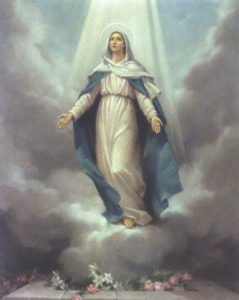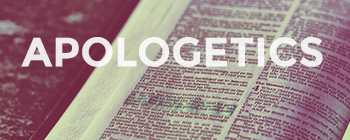 I started a conversation on the bus the other day and just before I got off the person handed me a copy of the news sheet from her local Catholic church. I put it in my pocket and forgot all about it.
I started a conversation on the bus the other day and just before I got off the person handed me a copy of the news sheet from her local Catholic church. I put it in my pocket and forgot all about it.
Finding it later, I read an article entitled ‘Assumptions’, which raised some interesting issues that I felt I needed to be able to make a reasoned defence. The article had relevance because it was written in August at the time of the ‘Feast of Assumption’ which celebrates the receiving of Mary back in to heaven.
The subject is introduced with these words:
“Those who rejected the authority of the Petrine See found in Holy Writ the sufficient authority on which to base true doctrine. But Holy Writ, clothing super natural truths in natural language, was found to be capable of diverse interpretation.”
The argument begins to develop that we need more than just Scripture. And, of course, if we are going to believe in a miraculous death of Mary to follow on from her sinless birth, then we are going to need more than Scripture. This argument develops until it reaches the following statement:
“Contradicting a fact of history, it was claimed that the Church was derived from the Book not the Book from the Church.”
I have never seen it put like that before, but what the writer goes on to explain is that as the Church was teaching certain truth before the Bible, as we know it, came onto the scene, the Bible becomes the encapsulating of what the Church was teaching and so it produced the Book.
However, what does the writer think the Bible is – just the New Testament? What we know as the Old Testament had been around long before the Church arrived, and these were the Scriptures that Jesus said contained things concerning Him (Luke 24:27). These were the Scriptures that Jesus said bore witness to Him (John 5:39). And these were Scriptures that were God-Breathed (2 Peter 1:21).
When Scripture gives such a definition to the Old Testament, surely, it is blasphemy to say that the Book is derived from the teachings of the Church – and, of course, by that the writer means the Roman Catholic Church. The Scriptures were around long before the Apostles were called by Jesus and the supposed first Pope was inaugurated. The true Church derives from the Scriptures, and is built upon the foundation of those that taught the Scriptures, and revealed the real Jesus (Ephesians 4:11ff and 1 Corinthians 3:11).
To give increased credence to a doctrine that nowhere is found in Scripture, we now read:
“Nor did the authentic Bible, when it arrived, claim that it contained all the truth there was or could be. As St. John’s Gospel expresses it, somewhat journalistically, ‘There were many other things that Jesus did, if all were written down, the world itself, I suppose, could not hold all the books that would have to be written’. (Jo.21v.25)
I wonder if the writer actually bothered to read these verses – did you notice what it says? There were many other things that Jesus did! It does not say that Jesus taught other things, especially, words that would contradicted what He had already said, or that would dilute the meaning of anything else recorded. Indeed, what the Holy Spirit inspired Paul to write to Timothy was that, all Scripture, not added traditions, equip a man of God (2 Timothy 3:16).
Having made this point, which as we can see denies the very Book, which we are told, derived from the Church, the way is made open to add the doctrine of the Assumption of Mary.
However, before we look at that we need to note something that the writer says in the final paragraph that Mary had,
“Already conceived without sin as possessing the fullness of grace”
The problem with this doctrine, of course, is it puts her on a par with Jesus, but the Bible shows something very different. John 1:1 shows that Jesus is eternal and so pre-existed and had a life that could be transferred into the womb. Mary was not eternal, she was created and, as Scripture shows, would be subject to sin along with all other created beings (Romans 3:23).
The Bible also shows that Jesus is the only One who knew no sin. (2 Corinthians 5:21; 1 Peter 2:22 and 1 John 3:5). Indeed Jesus is the only person without sin ever born on this earth was and as such the Bible shows Him to be the unique “only-begotten”.
Mary herself says in Luke 1:47 that God is my Saviour. The only way you can even begin to conceive the idea that Mary was born sinless is to ignore most of the Scriptures concerning man’s fall and redemption.
This is the teaching of Scripture – very different from the tradition referred to in this article.
Of course, the argument is that the proof of an immaculate conception is in the fact that Mary did not die and so we come full circle to the Assumption. And that is the case; it is a circular argument – either the Immaculate Conception and the Assumption are both right, or both are wrong – if one falls, they both fall. We have already seen that there is no Biblical proof concerning Mary being born sinless, and so that particular belief has already fallen, when weighed by Scripture, but what about the Assumption?
This central theme is explained like this:
“… (Mary had) like everybody else died and was buried, and that was almost that. Although Church interest concentrated on the nature of Christ until the Council of Nicaea and long afterwards, some attention turned to the Mother of God, which defined her as such in the Council of Ephesus in 431 A.D. Soon after this, Pope Sixtus III built a great basilica in her honour in Rome, Santa Maria Maggiore. By the middle of the 5th century, the emperor Marcion and his wife Pulcheria decided to go one better, as imperials tend to do. He would build a basilica with the body of Mary herself as its centrepiece. He sent to Jerusalem to have the body handed over. Bishop Juvenal had to admit with some embarrassment that although there was something called the tomb of our Lady in the city, it was empty, and no one could remember when it had been otherwise. Manuscripts from the later 4th century, Greek, Latin, Syriac, Coptic, Arabic and Ethiopic referred to Mary’s death, or rather dormition – sleeping -implying that she might have woken up. Soon the Christian world woke up to the fact that absence of any corporeal remains confirmed an oral tradition that, like her Son, she had risen from the dead. The Assumption is the word used to describe her resurrection and glorification in time.”
This seems to imply that since the 5th century, when this event was supposed to have taken place, the Catholic Church has believed and taught the Assumption of Mary. This is not the case.
In 1946, a letter was sent out to ask the people what they thought about the Assumption. Receiving an overwhelming response in favour, it was November 1, 1950 when Pope Pius XII proclaimed it a divinely revealed dogma. It was not anything in Scripture or, indeed, in tradition that led to this doctrine; it was not even the historic event – it was the vote of the people!
When you examine this evidence, the final sentence of the article seems rather out of place:
“The doctrine of her Assumption, then, is not something tacked on to the Christian tradition as an afterthought, but a truth arising inevitably from everything else we learn about her in the New Testament and about her Son.”
That is just not true, it was an afterthought tacked on in 1950. What I find interesting about this article is that it only claims that this truth arises from what is written in the New Testament, but no evidence is produced.
The New Testament does show that Mary was full of favour and chosen by God to bring the Son into the world, but she was not on a par with Jesus. She lived, she died and she indeed will have a resurrection but only as a glorified human being as the rest of us. That is what God reveals in His Word and even the will of 8 million people cannot override what He says.

